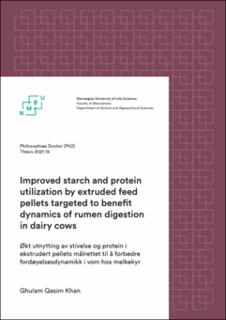| dc.description.abstract | To meet their requirements for energy and amino acids, high-producing dairy cows are fed compound feeds containing high amounts of starch and protein. Optimal utilization of these high-quality feeds is critical, where the rumen digestion represents the main challenge. In Norway, locally grown barley, oats, and wheat are commonly used as energy sources for dairy cows. The rapid rate of rumen starch fermentation of these grains is associated with rumen acidosis and metabolizable energy loss. Similarly, high-quality imported proteins can be subjected to increased rumen degradation and loss of valuable protein. Intestinal digestion of starch and protein is associated with better utilization of metabolizable energy and protein. Thus, shifting a part of starch and protein digestion from the rumen to the small intestine will increase the utilization of feeds.
Traditionally, rumen digestion is targeted by manipulating the rate of rumen degradation through the selection of ingredients and feed processing. However, since rumen digestion results from the concurrent rate of rumen degradation and rate of rumen passage, targeting also passage rate is an alternate strategy to alter rumen digestion behavior, but it is scarcely studied. The density is the main factor governing the rumen passage, where high-density particles have higher rumen outflow than low-density particles. Similarly, feed pellets with high density and rumen fluid stability may provide increased rumen escape. Since conventional pelleting provides limited ability to control density and fluid stability, it was hypothesized that feed pellets with high density and fluid stability produced using extrusion technique will increase the rumen escape and improve utilization of starch and protein. Moreover, it was hypothesized that low-density (floating) extruded pellets with high fluid stability will provide better synchronization between nutrient demand and release in the rumen. Therefore, either through increased rumen escape or slow degradation of starch, extruded pellet types will benefit the rumen environment more than conventional pellets.
The research presented herein was conducted in three experiments. Firstly, if extruder processing could be used to produce feed pellets with physical properties (like density and fluid stability) targeted to affect the probability of rumen escape using in vitro techniques was studied (Paper-I). Then, the effects of density and fluid stability of feed pellets on rumen digestion behavior of starch and protein were studied by measuring digestibility, the postprandial duodenal appearance of starch and protein, and the postprandial rumen fermentation patterns in dairy cows using in situ and in vivo methods (Paper- II and III).
In Paper-I, barley, maize, soybean meal (SBM), and two mixtures containing barley + SBM (50:50) and maize + SBM (50:50) were used as feed material. The processing conditions used were two settings in a hammer mill (feed materials ground with either 2 mm or 6 mm screen size) and four extrusion settings (screw rotation speed either 210 rpm or 300 rpm, and application of cooling or not in the last section of the extruder barrel) in a twin-screw extruder. This study revealed that density and fluid stability of feed pellets from pure cereal (starch-rich) grains could be easily targeted by manipulation of screw speed and temperature in the last section of the extruder barrel, whereas feeds containing a high proportion of protein ingredients will require other processing settings.
In Paper-II, three pure barley extruded treatments having pellets of either low-, medium-, or high-density were used in a 3×3 Latin square design with three cannulated lactating Danish Holstein cows. In Paper-III, four treatments containing 70% barley and 30% SBM (as-is basis) were used in a 4×4 Latin square design with four cannulated lactating Norwegian Red cows. One treatment (control) was pelleted by conventional pelleting after expander processing, whereas the other treatments were extruded using three distinct settings giving pellets with either low-, medium-, or high-density. Conventional pellets had high-density but markedly lower fluid stability compared with extruded pellets.
Both experiments (Paper- II and III) demonstrated that high-density extruded pellets have a lower rumen degradation rate and greater rumen escape of starch, and thus lower rumen starch digestion (RSD) than other density pellets. However, despite having lower fluid stability and a higher starch degradation rate, the RSD of conventional pellets did not differ from the high-density extruded pellets. Although similar mean duodenal appearance, conventional pellets had a more rapid rumen outflow of starch after entering the rumen than high-density extruded pellets. About 98% of starch intake was digested up to distal ilium with all pellet types, indicating high small intestinal digestibility of starch. Consequently, the total tract digestibility of starch was more than 98% with all pellet types. Except for high propionate concentration in the dorsal rumen for low-density extruded pellets (Paper-III), no clear patterns for rumen fermentation variables were observed with respect to the physical properties of pellets. However, the acetate:propionate ratio was lower for low-density than high-density extruded pellets (Paper-II). Moreover, diurnal rumen pH was lower for extruded pellets than conventional pellets (Paper-III). In contrast to starch, no clear pattern of rumen digestion of protein with respect to the physical properties of feed pellets was observed. However, the duodenal flow of crude protein was higher for extruded pellets, especially low-density pellets, than for conventional pellets. Total tract NDF digestibility remained unaffected among treatments, but ruminal NDF digestibility was lower with extruded pellets than conventional pellets.
Overall, it can be concluded that the dynamics of rumen digestion of concentrate feeds can be manipulated by the physical properties of pellets, where density appeared to be the main property determining patterns of rumen digestion. Moreover, no evidence was found that extruded pellets are more beneficial for the rumen environment than conventional pellets. The findings in this thesis need further investigations. | en_US |

